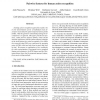Free Online Productivity Tools
i2Speak
i2Symbol
i2OCR
iTex2Img
iWeb2Print
iWeb2Shot
i2Type
iPdf2Split
iPdf2Merge
i2Bopomofo
i2Arabic
i2Style
i2Image
i2PDF
iLatex2Rtf
Sci2ools
ICPR
2010
IEEE
2010
IEEE
Pairwise Features for Human Action Recognition
Existing action recognition approaches mainly rely on the discriminative power of individual local descriptors extracted from spatio-temporal interest points (STIP), while the geometric relationships among the local features1 are ignored. This paper presents new features, called pairwise features (PWF), which encode both the appearance and the spatio-temporal relations of the local features for action recognition. First STIPs are extracted, then PWFs are constructed by grouping pairs of STIPs which are both close in space and close in time. We propose a combination of two codebooks for video representation. Experiments on two standard human action datasets: the KTH dataset and the Weizmann dataset show that the proposed approach outperforms most existing methods. Key-words: action recognition, local features, pairwise features.
Related Content
| Added | 23 Jun 2010 |
| Updated | 23 Jun 2010 |
| Type | Conference |
| Year | 2010 |
| Where | ICPR |
| Authors | Anh Phuong Ta, Christian Wolf, Guillaume Lavoue, Atilla Baskurt, Jolion Jolion |
Comments (0)

